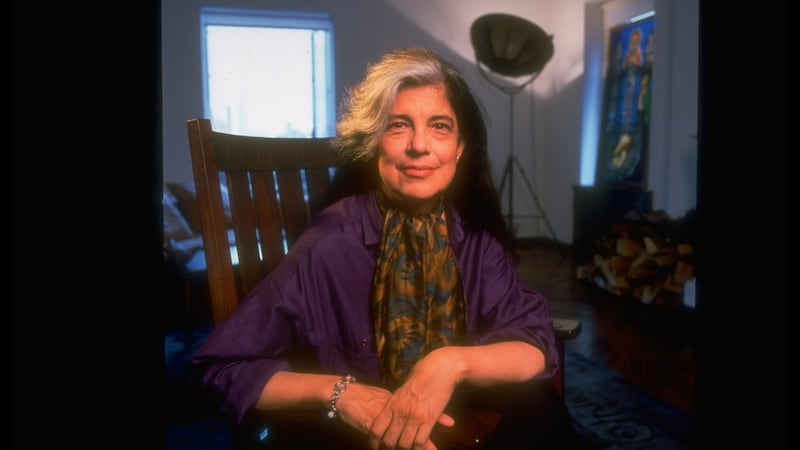In 1965 Susan Sontag – fresh from publishing her landmark essay Notes on “Camp” – was whisked away in a limousine to a hip nightclub notorious for its strict door policy. A member of her party whispered something in the bouncer’s ear, whereupon they were ushered in ahead of the lengthy queue. “I said, ‘We’re with Susan Sontag,’ ” her friend later confided, when she asked how he had worked his magic.
The young woman, still only in her early 30s, was astonished to discover that her name had become an “open sesame” to high society. Despite being filmed by Andy Warhol or dining out with Jacqueline Kennedy, the budding intellectual superstar felt like a figment of her own imagination. This discrepancy between the “real me” and the “self-for-others” lies at the heart of Benjamin Moser’s fittingly monumental authorised biography. Running to more than 700 pages (excluding notes and index) and drawing on a wealth of hitherto inaccessible material, as well as scores of interviews, Sontag: Her Life has a strong claim to definitive status.
Sontag herself may well be the ideal candidate for a literary biography. She once observed that an author’s journal allows us to “read the writer in the first person” and “encounter the ego behind the masks of ego”, but what her own diaries reveal is essentially a lack of ego, or at best one so amorphous as to be a blank slate.
To say that Sontag was a divided self is not the half of it. “I have always liked to pretend my body isn’t there,” she confessed, despite coming across, in the 1960s, as the love child of Alcibiades and Socrates, or Monroe and Einstein. This accounts, inter alia, for her lifelong hygiene issues (she had to remind herself – in longhand – to take baths and clean her teeth); her punishing, speed-fuelled nocturnal writing routine (WH Auden was one of her dealers) or failure to even mention she had cancer in Illness as Metaphor.
Passionate affair
Moser chronicles Sontag’s regular attempts to resolve what she called the “agonised dichotomy between the body and the mind”, which she identified early on as the source of her “greatest unhappiness”. These could take a predictably theoretical shape, as in her work on Antonin Artaud, who had sought, she wrote, “to heal the split between language and flesh”, or her concomitant interest in Gnosticism, which held out the promise of reconciling “all dualisms”. At other times she would make a concerted effort to “emerge from her head into her body”, perhaps most successfully during her passionate affair with playwright María Irene Fornés, who introduced her to sexual pleasure. She described (in comically abstract terms) “[t]he coming of the orgasm” as “the birth of [her] ego”, going as far as to claim that she “didn’t exist in the sense that others and everything else did” prior to this most seminal of events.

Her busy, tempestuous sentimental life failed, however, to provide any semblance of plenitude. Sontag always conceived of relationships as a struggle between master and slave (usually playing the former role with men and the latter with women, although her bullying of long-term partner Annie Leibovitz takes some beating). This power dynamic was even internalised, with “Miss Librarian” – as she called her geeky, gawky self – constantly berated and spurred on to better things by “that person who has been watching me as long as I can remember”.
At the tender age of 11, Sontag made the (as she put it) “conscious decision” to become popular, thus embarking on a lifelong “project of self-transformation” underpinned by a pressing need “to see more, to hear more, to feel more”. As a schoolgirl, she could be found studying Kant’s Critique of Pure Reason, concealed behind a copy of the Reader’s Digest she was really meant to be focusing on. By the age of 16 she was studying at Chicago – then the US’s most intellectually rigorous university – having already spent a year at Berkeley. And that was only the beginning. As Moser points out, she often tried to find herself in works of art in which she could lose herself. Her quest for a heightened sense of reality doubtless culminated when she directed Waiting for Godot in a besieged Sarajevo: “This is not ‘symbolic’,” she declared, as though she had just brought down the Matrix. “This is real.”
Self-creation
Writing, for her, was not so much a means of self-expression – having little self to express in the first place – but one of self-creation. Convinced that all good writers are “roaring egotists”, she coveted the persona of the great author, which would counteract her inclination “to hide, to be invisible”, itself compounded by her homosexuality. “I need the identity as a weapon,” she stated in 1959, “to match the weapon that society has against me.”

The imperious diva of later years – with her trademark Cruella de Vil hairdo – may have lorded it over Manhattan’s intelligentsia, but still felt, whenever she was alone, like the little girl she had tried so hard to outgrow. The part of herself she had spent a lifetime attempting to leave behind was, paradoxically enough, the only one that felt truly authentic, no doubt because it was born of deep trauma (a dead father and an alcoholic mother). Moser shows how fame inevitably widened this gap “between the simulacrum, the metaphor, the mask, the persona and the self found in silence”. Sontag’s adoption of the larger-than-life persona of the Great American Novelist was also at odds with the negative capability that informs some her best works, which may well have reinforced her feeling of inauthenticity.
Sontag’s greatest creation was, ultimately, Susan Sontag herself, and the two were “neither completely distinct nor completely identical”, just like an image and the object it represents. As her biographer puts it, twice – but it is worth repeating – she “created the mould, then broke it”.












